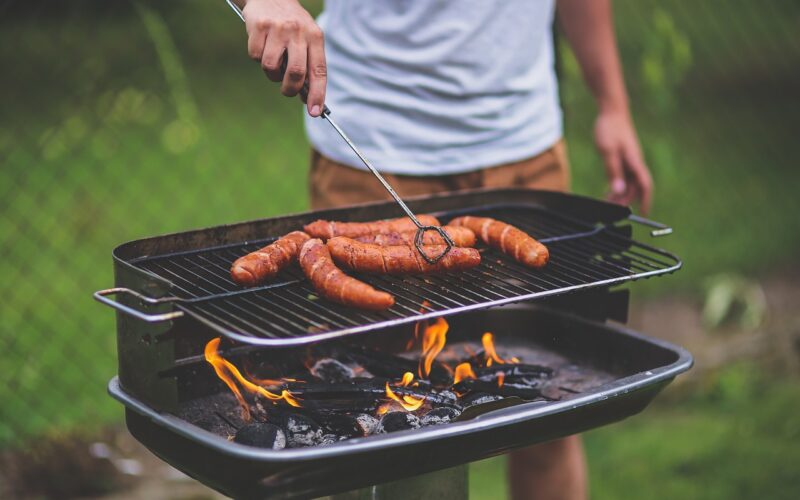Santa Maria-style grilling has become an iconic California tradition offering a unique take on traditional barbecue. This cherished regional cooking method stands apart from its historical roots to its distinctive design features.
By understanding the origins, mechanics, flavors, and proper techniques behind the Santa Maria grill, you can fully appreciate the uniqueness of this versatile outdoor cooking appliance.
Historical Background
Santa Maria style grills emerged in the late 19th century from the ranching culture of California’s Central Coast. Ranch hands-cooked tough cuts of beef over fragrant red oak coals, enhancing flavor while tenderizing the meat. Metal farm tools like harrows and plow shares served as early grilling grates to suspend food above the fire.
This rustic style of open-flame barbecue became a regional tradition, with restaurants first popularizing tri-tip grilled Santa Maria style by the 1930s. Locals incorporated the grills into community gatherings and family barbecues. Though details evolved, the early ranch style’s simple ethos and smoky flavors endured over generations.
Signature Design Features
At the grill’s heart sits an adjustable crank that allows raising or lowering the grate to control heat, a signature Santa Maria feature. Grate designs are elongated to accommodate large cuts. Stainless steel rods allow smoky heat to envelop foods while preventing flare-ups. Wood burned down to coals provides indirect heating for slow cooking.
Overall, simplicity is prioritized, while durability is maximized to ensure long-term performance. Many designs feature high-quality marine-grade stainless steel, which adds to the aesthetic appeal and guarantees resistance against corrosion.
The heavy welded bases also provide exceptional stability, allowing you to cook confidently. With their versatile nature, Santa Maria grills are known for delivering an authentic wood-fired flavor that enhances the taste profiles of various ingredients, creating a truly remarkable culinary experience.
Unique Cooking Techniques
Santa Maria Barbecue uses indirect heat to cook meats infused with oak smoke gently. Dripping juices prevents burning. The long, narrow grate design accommodates turning large cuts perpendicular to the crank axis when flipping.
While tri-tip is traditional, these grills can handle diverse proteins. Low heat thoroughly penetrates while a subtle smoky essence permeates the meat. The simplicity allows culinary creativity across different tastes and ingredients.
Local Flavor and Community
Santa Maria-style barbecue resonates so deeply thanks partly to its integration into the regional culture. Rancher-inspired seasonings like salt, pepper, and garlic create a signature flavor profile. Locally grown pinquito beans and grilled bread accompany the smoky meat. Wines from the region’s vineyards pair perfectly.
Beyond cuisine, these grills bring communities together. Santa Maria-style barbecues feature prominently at local fairs, farmers’ markets, and rodeos, feeding crowds and celebrating traditions. Families pass down knowledge and custom grills through generations.
Comparisons to Other Grills
Contrasting stainless construction to masonry barbecues, the Santa Maria style sacrifices heat retention and requires fire management. But portability and ability to harness real wood smoke make them superior for authentic barbecue flavor. Powerful gas models lose the nuance of cooking over coals.
While requiring skill, Santa Maria grills offer unmatched versatility, from searing steaks to low-and-slow barbecue. Patience and practice unlock their capabilities. Once mastered, a Santa Maria grill is the ultimate outdoor cooking appliance.
Tips for Success
Achieving barbecue perfection on a Santa Maria grill requires the following basic guidelines:
- Red oak logs burned down to glowing coals to generate even, indirect heat.
- Keep the grill interior clean and debris-free. Oil grates for ideal sear marks.
- Allow an hour for the coals to burn down before cooking.
- Start with more coals than you think necessary. Adjust grate height periodically to maintain proper temperature.
- Rotate and flip meat gently to prevent abrasion or losing juices.
- Follow local health department safety rules for operation and minimum clearance.
Discover the Secrets of Santa Maria-style Barbecue
With its roots in California history and a devoted fanbase, Santa Maria-style barbecue occupies a unique niche. The personalized craftsmanship and authentic open-flame cooking experience place it in a class of its own. Anyone can harness these grills’ magic by learning time-honored tips and techniques. Their versatility and wood-fired flavors make Santa Maria grills a prized backyard investment.

